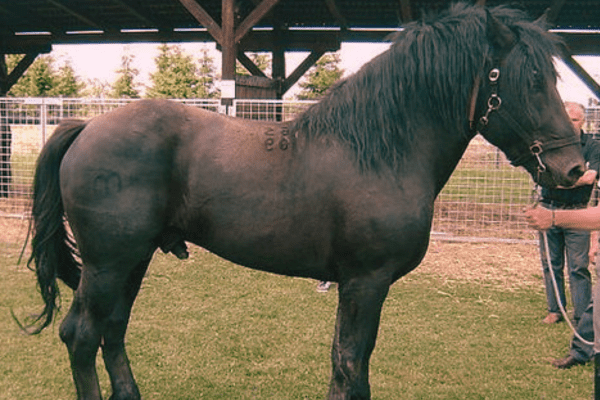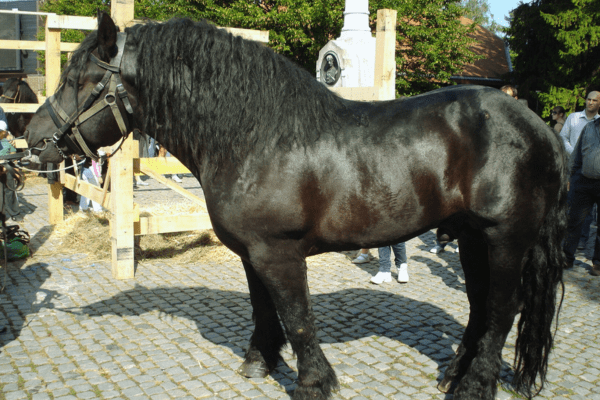Hailing from the serene northern reaches of Croatia, in Međimurje County, the Međimurje horse stands as a distinguished breed of medium-heavy draught horses. Esteemed for their captivating beauty, steady temperament, and agreeable nature, these horses represent a vital part of Croatia’s rural tapestry.
The Međimurje horse, with its harmonious blend of strength and gentleness, continues to be a symbol of the region’s rich equine legacy.
History
Early Beginnings and Crossbreeding Innovations
Era of Origin: The genesis of the Međimurje horse can be traced back to a pivotal period between the late 18th and early 19th centuries. This era marked the beginning of a significant chapter in the breed’s development.
Crossbreeding Practices: The foundational process involved the selective breeding of native mares, known for their Anglo-Arabian characteristics, with imported stallions from esteemed European breeds. This included the robust Noriker, the resilient Ardennes, the sturdy Percheron, and the powerful Brabant.
Resulting Traits: The outcome of this meticulous crossbreeding was a breed that combined strength, endurance, and versatility, a testament to the diverse genetic heritage it encompassed.
Geopolitical Influences and Distribution
Administrative Context: During its formative years, Međimurje County was under the administrative purview of Hungary’s Zala County. This historical fact significantly influenced perceptions and classifications of the breed in international equine literature, often leading to its identification as Hungarian.
Expansion Across Borders: The Međimurje horse’s adaptability and resilience led to its proliferation across the Habsburg monarchy. It was not confined to northern Croatia; the breed also found homes in regions like Zagorje and Podravina, as well as in southwestern Hungary, eastern Slovenia, and eastern Austria.
Decline and Conservation Efforts
Widespread Popularity: Initially, the Međimurje horse enjoyed widespread popularity across these regions, appreciated for its work ethic and adaptability in various agricultural and transportation roles.
Current Status: In contemporary times, however, the breed faces significant challenges. With only a small population of approximately 40 individuals remaining in Croatia, its native land, the Međimurje horse is at a critical point of potential extinction.
International Populations: While a larger population exists in the areas north of the Mura River in Hungary and in parts of eastern Slovenia, these numbers are not substantial enough to ensure the breed’s long-term survival.
The history of the Međimurje horse is a rich tapestry that intertwines genetic diversity, cross-border influences, and the changing tides of agricultural practices. Its journey from a widely recognized workhorse to an endangered breed underscores the need for concerted conservation efforts.
Preserving the Međimurje horse is not only about saving a breed; it’s about protecting a unique segment of European equine heritage, a living testament to a time when horses were integral to everyday life and cross-regional interactions. As efforts to safeguard this breed continue, the Međimurje horse stands as a symbol of both historical legacy and the urgent need for biodiversity preservation in our modern world.
Characteristics:
Physical Stature and Build
Size Range: The Međimurje horse typically stands tall, with a height range from 155 cm (15.1 hands; 61 inches) to 165 cm (16.1 hands; 65 inches), showcasing its robust stature.
Weight of Stallions: The males of this breed, the stallions, can reach substantial weights, tipping the scales at up to 900 kilograms (2,000 pounds), underscoring their significant physical presence.
Comparison with Croatian Breeds: When compared to other Croatian cold-blood breeds, the Međimurje horse is notably larger. It surpasses the Posavac horse, which averages between 140–150 cm in height, and aligns more closely in size with the Croatian Coldblood horse, standing between 150–160 cm.
Physical Features
Head and Neck: This breed is characterized by a relatively small head and petite ears, coupled with a short but strong neck. These features contribute to a distinctive profile.
Body Structure: The Međimurje horse boasts pronounced withers, powerful shoulders, a well-developed chest, and sturdy legs, all hallmarks of its strength and capability for work.
Color Variations
Dominant Colors: The most common coat colors for this breed are bay and seal brown, followed by black. These shades add to the horse’s striking appearance.
Rarity of Other Colors: While other color variations do exist within the breed, they are considerably rarer, adding a unique aspect to individual horses.
Temperament and Usage
Disposition: Known for their calm, even, and affectionate temperament, these horses are distinguished by their good obedience and willingness to work. This makes them well-suited for various tasks, whether pulling wagons or assisting in field and forest work.
Changing Roles: The advent of machinery in agriculture has diminished the traditional roles of the Međimurje horse, leading to a shift towards horsemeat production in contemporary times.
Genetic Distinctiveness
Recent Genetic Studies: Recent genetic analyses, involving mitochondrial DNA samples from a significant number of both Croatian and Hungarian populations of the breed, as well as related breeds (like the Posavac horse and Croatian Coldblood horse), have provided insightful revelations.
Autochthonous Breed: These studies confirm that the Međimurje horse is an autochthonous breed, with its origins intricately linked to other, mostly neighboring, cold-blooded horse breeds. This genetic lineage highlights the breed’s unique place in the equine world.

Preservation Efforts and Modern Day Use:
In recent years, there has been a growing awareness of the need to preserve the Međimurje horse. With their numbers dwindling, various organizations and breeders in Croatia have begun initiatives to protect and promote the breed. These efforts include breeding programs, participation in cultural events, and educational campaigns to raise awareness about the breed’s heritage and potential.
Today, the Međimurje horse is not only a symbol of regional pride but also an increasingly popular choice for recreational riding and competitive driving sports. Their versatility and endurance make them well-suited for various equestrian disciplines, from dressage to marathon driving.

